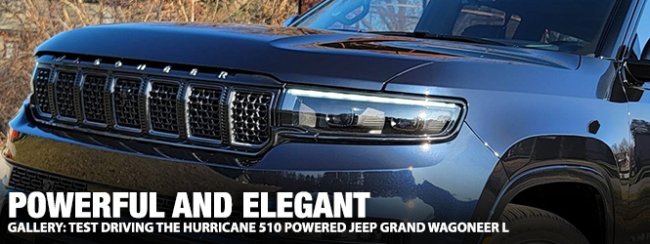
The Jeep brand raised some eyebrows when it was announced that a new twin turbocharged inline-six would be replacing the V8 in most configurations of the range-topping Wagoneer and Grand Wagoneer, including the long wheelbase “L” models. Although both versions of the new Hurricane I6 engine family offer impressive power – each offering more horsepower and torque than the Hemi V8s that they effectively replace – skeptics worry that these small engines with big boost will labor to move a large vehicle.
This editor recently spent a week driving a new Jeep Grand Wagoneer L Series II Obsidian with the new Hurricane 510. After logging more than 800 miles, there were no real complaints about this new engine. Although the roar of a 392 V8 was missed from a previous Grand Wagoneer test vehicle, there really is not any downside to the new twin turbocharged I6 Hurricane engine.
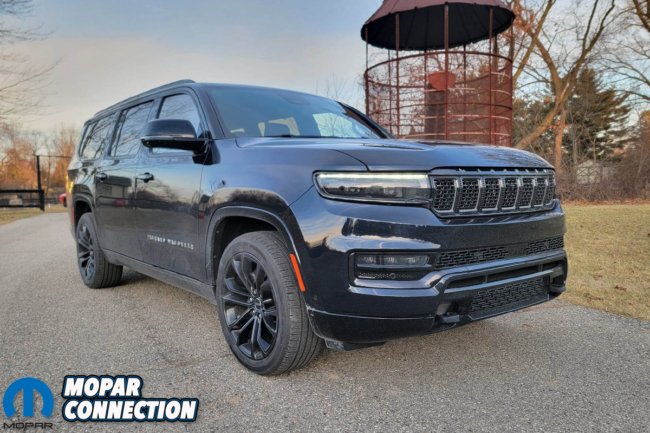
While the Grand Wagoneer L with the Hurricane 510 was in possession for testing, a family health issue gave a good reason to make a quick trip to Pennsylvania. That trip allowed us to experience the big Jeep far better than just daily driving.
The 700 mile highway drive began in Michigan and ended in Pennsylvania. We started out in morning rush hour, then a long drive across the Ohio Turnpike, which is relatively flat, before heading into the hills around Pittsburgh. With the high tech adaptive cruise control system set to a number just slightly higher than the speed limit (70 in most places on my route), we averaged 19.1 miles per gallon.
That number isn’t going to draw many buyers, but the fuel economy is really the only downside to the Grand Wagoneer as a whole. However, for a huge, heavy SUV that is packed with massaging seats and screens all over the place, that is a pretty solid number. It is also better than gasoline-powered Cadillac Escalade owners can expect and there is no question that the big Caddy is the closest competitor for the Grand Wagoneer.

Fuel economy aside, the new twin turbocharged inline-six “Hurricane 510” is a great engine. It provides great power through the mid-range, so when you are accelerating away from traffic or asking for more power to pass slower-moving traffic, the small engine is quick to respond with 510 horsepower and 500 lb-ft of torque.
From a stop, the inline-six doesn’t provide that initial hit of power that you get from the 392 cubic inch V8 that is also available in some trim levels of the Grand Wagoneer. For a relatively small forced induction engine, it spools up and does makes power in a hurry.
That being said, no small forced induction engine is going to offer the quick hit of torque that you get from a naturally aspirated V8, but the Hurricane 510 hits harder and quicker than many turbocharged production engines on the market today.

While cruising down the highway at 70-75 miles per hour, the six cylinder engine doesn’t sound like it is working very hard, which is often an issue when you put a small engine in a big vehicle like the Jeep Grand Wagoneer.
When an incline was approached on the highway, the 8-speed transmission quickly moved to a gear that allowed the twin turbocharged engine to immediately get into the peak powerband. Even on steep hills, the big Jeep with a small engine doesn’t feel like it is struggling to move the weight.
On the way back to Michigan, there was a little more urgency and the weather was rainy with a ton of wind. The Wagoneer was loaded down with a few hundred pounds of random childhood stuff in the cargo area. Cruising at well above the speed limit with a headwind, the twin turbocharged Grand Wagoneer still got 17.1 miles per gallon.

The 2023 Jeep Grand Wagoneer Series II Obsidian was equipped with heated, massaging seats with 20-way adjustment, a heated steering wheel and the 23-speaker McIntosh sound system. This made the long drive comfortable and enjoyable. The 20-way adjustable seats allow an incredible level of customization for the perfect seating position. The various massaging programs help to ease away any back pain that you had before buckling in for the ride.
As for the McIntosh sound system, thanks to the UConnect infotainment system with Android Auto, it was easy to connect a phone to and listen to Spotify while using Google Maps.
The 23-speaker system provides impressive sound quality at all volume levels. While it doesn’t have the booming bass that you get from some modern audio systems, what it lacks in boom it makes up for with overall sound quality.
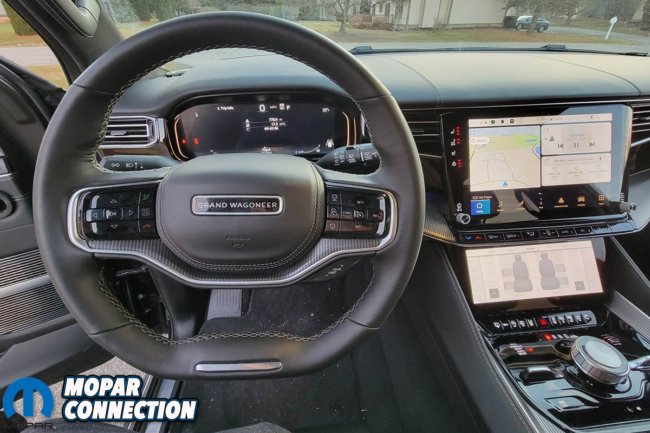
Along the way, Google Maps alerted of several speed traps with 100% accuracy. When headed home, not a single speed trap was on the map or along the side of the road. Thanks to the layout of the 12-inch UConnect screen in the center of the dash, it is easy to flip back and forth from navigation to music options within Android Auto.
It is also just as easy to access any of the other programs controlled by the touchscreen. Thanks to the lower screen, seating functions and climate control are easily controlled without leaving the map or music screen. Android Auto will connect wirelessly, but a direct connection via the USB port behind the HVAC control screen, prevented any connectivity issues in more remote areas of the drive.
The Grand Wagoneer L test vehicle was equipped with the second-row entertainment system. This would have been ideal for any rear-riding passengers on a long road trip, but for this one, there were no passengers to take advantage.

There is a refrigerator that is mounted in the base of the center console armrest, which kept drinks cold during the long drive. The cooling unit in the center console is brilliant and really wonder why more premium vehicles do not offer something like that.
When you turn it off, it operates like any other normal storage compartment. There is really no downside to it, but then again there are no real downsides to the Jeep Grand Wagoneer as a whole.
The key difference between the area in Michigan and our destination in Pennsylvania, is that the Michigan area is comprised entirely of long, straight, flat roads. While the area in Pennsylvania is hilly with lots of twisty roads. The local roads in Pennsylvania are great for testing the handling capabilities of a vehicle and the Grand Wagoneer L handles like you probably guessed, like a huge SUV.
However, it does not handle like a huge truck, which is key since it is built on a truck-based chassis. You aren’t going to win any road races with the extended wheelbase Grand Wagoneer, but even on tight turns with elevation changes, the adaptive suspension does a beautiful job of keeping the body steady while keeping all four tires securely on the ground.

As large SUVs go, the Grand Wagoneer L handles very nicely and it rides like a dream. Almost none of the imperfections on the road make it into the cabin, the ride is smooth and quiet on even rougher pavement. In fact, we had a passenger that always hates how trucks and truck-based SUVs ride, but they repeatedly praised the ride quality and the comfortable passenger seat of the Grand Wagoneer L.
Realistically, few people who buy a Jeep Grand Wagoneer L will be all that concerned about handling, but between the confident feel in turns and the ride quality, it is hard to find any faults with the driving dynamics of this big SUV.
While the long highway drive gave plenty of time to experience the mid-range and top speed abilities of the Grand Wagoneer L with the Hurricane 510, driving around the country roads of rural Pennsylvania tested the low end acceleration abilities.

As mentioned above, it doesn’t offer that initial hit of torque that the 392 Hemi provides, but when launching hard from a stop, both the driver and passengers can feel when the boost level immediately reaches its peak numbers and power levels climb. As soon as the boost hits, the Hurricane 510 pushes you back in the seat and holds you there through each shift, until you lift.
The acceleration forces are enough to impress another passenger, who has been drag racing V8 engines since the 1950s. Their only complaint was the sound, although they pointed out that it sounds better than many of the high powered foreign six cylinder engines or Ford’s EcoBoost V6 options.
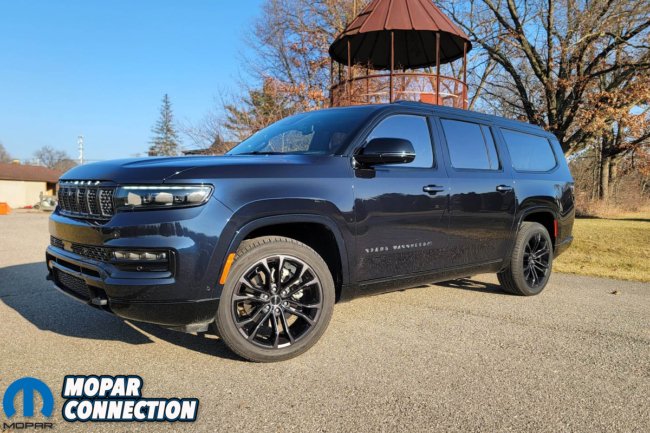
This engine is impressive enough in this big heavy Jeep, we expect it to be a great engine in smaller, lighter vehicles – be it a Ram 1500 or a next generation muscle car. Unless you absolutely must have the sound of the Hemi, any prospective buyers shouldn’t hesitate to give this new engine a chance. We suspect that most people who test drive the Grand Wagoneer with the Hurricane 510 will enjoy it enough to buy it.
The only real downside to the new Jeep Grand Wagoneer is the price, as the Series II Obsidian rung in at just over $109,000. It is not for everyone, but anyone considering a large, premium SUV should test drive a new Grand Wagoneer before buying anything else.










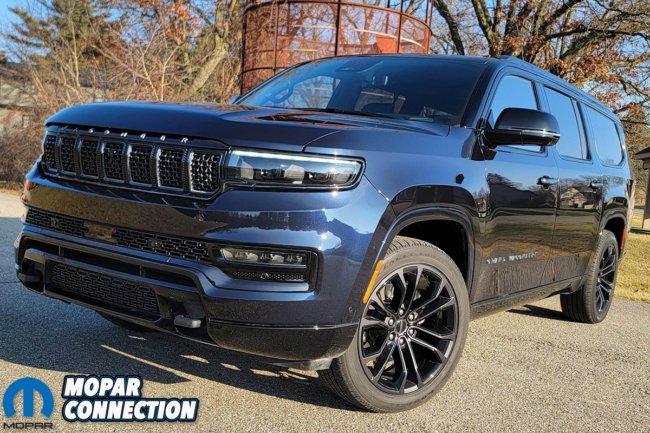




 Mopar Connection Magazine – The ONLY Daily Mopar Magazine © 2022. All Rights Reserved. Mopar Connection Magazine is the ONLY daily Mopar Magazine bringing you the latest Mopar news, technology, breaking news, and Mopar related events and articles. Find out the latest information about Mopar, Mopar products and services, stay up to date on Mopar enthusiast news, dealership information and the latest Mopar social media buzz! Sign up for the Mopar Connection Magazine newsletter for the latest information about new products, services and industry chatter. Mopar Connection Magazine is the best and only source you need to be a Mopar industry insider!
Mopar Connection Magazine – The ONLY Daily Mopar Magazine © 2022. All Rights Reserved. Mopar Connection Magazine is the ONLY daily Mopar Magazine bringing you the latest Mopar news, technology, breaking news, and Mopar related events and articles. Find out the latest information about Mopar, Mopar products and services, stay up to date on Mopar enthusiast news, dealership information and the latest Mopar social media buzz! Sign up for the Mopar Connection Magazine newsletter for the latest information about new products, services and industry chatter. Mopar Connection Magazine is the best and only source you need to be a Mopar industry insider! by
by